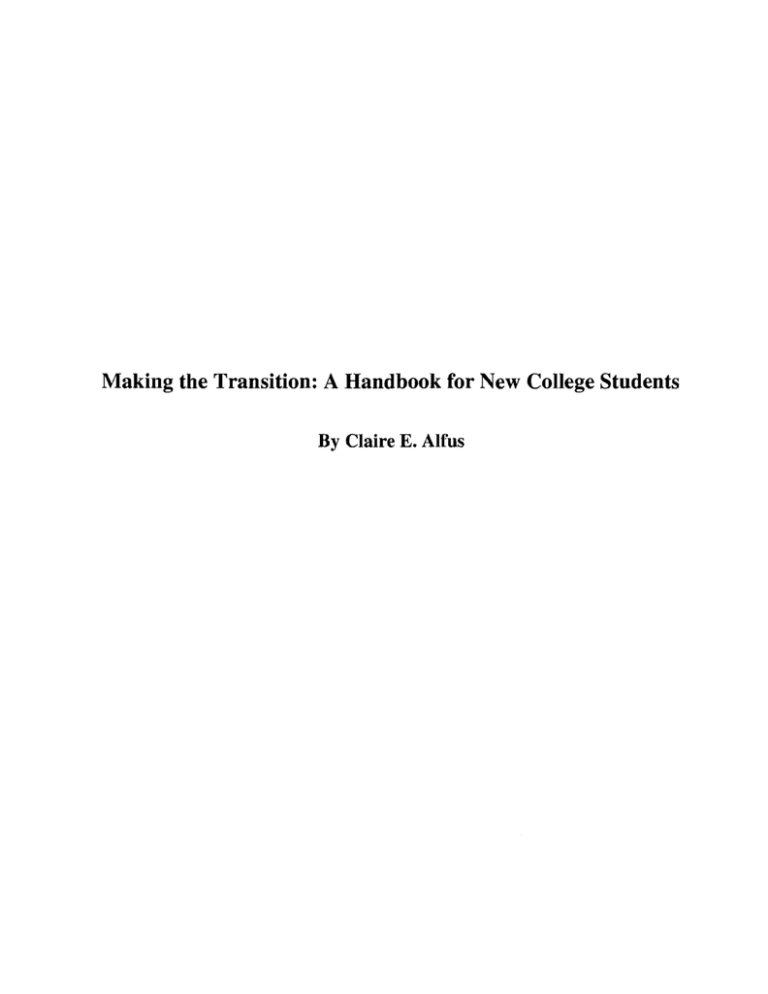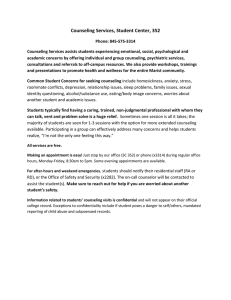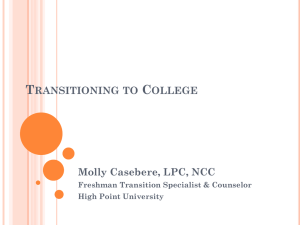Making the Transition: A Handbook for New College Students
advertisement

Making the Transition: A Handbook for New College Students By Claire E. Alfus Making the Transition: A Handbook for New College Students An Honors Thesis (HONRS 499) by Claire E. Alfus Mary Moore Ball State University Muncie, Indiana May 2005 Expected Date of Graduation: May 7,2005 j ., i :' I '. Abstract In the American culture, attending college is an opportunity that many students embrace. However, prior to college, students already hold views and stereotypes about the ideal college experience, created chiefly by the popular media. Many new students are unaware of the large transition that occurs when they leave high school and enter college. Along with this transition comes a variety of unfamiliar feelings for some students, such as homesickness, loneliness, and depression. Unfortunately, there are few resources to help students prepare for the more personal and emotional aspect of this transition. I have designed a handbook for incoming freshmen to better prepare them for the emotions that are overlooked by the popular media and oftentimes, by colleges and universities themselves. Within this handbook, students will be able to read about the causes, symptoms, and coping methods for homesickness, loneliness, and depression. Also, students will have the opportunity to become more familiar with their own college expectations, the hesitations toward seeking counseling, the side effects of refusing help, certain methods for helping friends, and where to find additional resources for homesickness, loneliness, and depression. Acknowledgements • I would like to thank Mary Moore for her help in advising me with this project. She was encouraging, optimistic, helpful, and incredibly patient. • I would also like to thank the helpful Ball State University Counseling Center employees for answering my many questions. • Finally, I would like to thank Melissa, Rachel, Hal, and Anne for giving me so much firsthand experience. Thesis Rationale 1 RUNNING HEAD: Thesis Rationale Thesis Rationale Claire E. Alfus Ball State University Thesis Rationale 2 Thesis Rationale Claire E. Alfus Introduction My thesis, a student handbook entitled Making the Transition: A Handbookfor New College Students, discusses the feelings of homesickness, loneliness, and depression in the transition from high school to college. However, before I could collect my information, I had to research the necessity for such a brochure on college campuses. I first looked at why students experienced homesickness, loneliness, and depression when transitioning to college. I then spent time researching what resources Ball State University has to offer its new students. Finally, I compiled a list of reasons why a handbook of this nature would be beneficial to new college students. The following three sections explain in detail what I have found through my research. Background Information When high school graduates begin the transition from home to college, it is seen as an exciting time full of change, freedom, and new opportunities. The popular media reinforces many traditional stereotypes about the ideal college experience, but fails to even touch upon the more personal aspects of the transition, such as feeling homesick, lonely, or depressed. However, it is not only the media that is at fault. Colleges often do not prepare an adequate or thorough presentation of the realities of college or university life. Even when new students attend their scheduled orientation before the school year has started, they are shown college from an exciting and optimistic viewpoint. Unfortunately, this repeated portrayal of college, by both the media and the universities themselves, leads to a somewhat distorted and unrealistic picture of a typical college experience. In turn, students may wonder why their college experience is not exactly Thesis Rationale 3 what they had imagined, especially if the students begin to experience unfamiliar emotions, such as homesickness, loneliness, or depression. Popular films, such as "Animal House" or "American Pie 2," television shows, such as "Dawson's Creek" or "Felicity," and advertisements, such as those generated by Linens and Things or Target, all portray a positive college experience. However, within their portrayals, there are often two conflicting college experiences shown. On one hand, a more conservative side of college is presented: old brick buildings covered in ivy, full lecture halls lead by spirited professors, late nights at the library, students lounging on the quad, reading or playing Frisbee, and impossible workloads of papers and projects. This side of college advocates working hard, attending class, and thriving in the academic environment. Yet within the popular media, another side is presented. This side conveys the fun and freedom of college: fraternities and sororities, large parties, going to bars, spending endless time with friends, and being fashionable and popular. Many new students may view the college experience as a mix of these two portrayals, despite the unrealistic nature of both. It seems that the media ignores the common college experiences for new students, such as homesickness, loneliness, and depression. These feelings and experiences are glazed over and essentially overshadowed and ignored by the more popular stereotypes of college life. What then, are students to think when they begin feeling these emotions? Many new students often believe that they are the only students facing these obstacles, so they choose not to express their feelings. However, these feelings and experiences are important and must not be ignored. They are prevalent on college campuses, but due to the lack of discussion about them, seem to be almost nonexistent. Because popular portrayals of college rarely show these feelings, they almost never present individuals seeking the necessary help to improve. How, then, do new students take care Thesis Rationale 4 of their feelings? Often, they wait for the feelings to subside, but this can be detrimental to their physical, emotional, and mental health as well as to their academic success. If students are too embarrassed to seek help from their counseling center or from other people, their initial feelings can seriously affect their college experience. According to research, there are many students experiencing a more difficult transition to college. Researchers at Kansas State University took part in a 13·year study that looked at students seeking help at a large Midwestern university counseling center. After studying over 13,000 students from 1989 to 2001, the researchers concluded that "students experience more stress, more anxiety, and more depression than a decade ago. The number of students seen each year with depression doubled, while the number of suicidal students tripled." (APA, 2005). Ball State University's Expo magazine noted that more than 85 percent of colleges and universities report seeing more students with severe psychological problems (2005, p. 13). Also, from the Ball State University Counseling Center, it was reported that in a 2003 survey of randomly selected Ball State students, almost 35 percent of those surveyed indicated that they had been depressed" 1-10 times last year at a level that interfered with their ability to function." Another 25 percent of the students surveyed felt depressed more than ten times per year or had been diagnosed as depressed. These conditions do not only affect students emotionally, but affects their academic perfonnance as well. A study found that "students with higher levels of psychological distress were characterized by higher test anxiety, lower academic self·efficacy, and less effective time management and use of study resources" (APA, 2005). Also, mental health problems can affect the retention and graduation rates at schools. Obviously, then, this problem of psychological distress expands beyond one's personal emotions. Thesis Rationale 5 There is indeed a growing population of students suffering from various psychological conditions on college campuses. However, it is likely that some of these problems could be prevented if students were given concrete and realistic information about the transition to college. Paul and Brier (2001) argued that "the first year of college is the most difficult period of adjustment that a student faces" (p.l). Also, they wrote that it "is imperative that researchers and practitioners strive to untangle and understand the complex web of social and intellectual challenges facing new college students and develop prevention and intervention efforts" (p.l). The idea of prevention is key when preparing students for the transition from high school to college, but yet it is not readily available on most college campuses. Resources at Ball State University Before beginning my thesis, I had to ensure that the Ball State University Counseling Center did not already provide a similar brochure. After speaking with various employees at the counseling center, I discovered that although the center works to make students aware of the counseling center and its services during orientation, there was no specific brochure or handout that dealt with transitioning to college. During orientation, families attend a half-hour presentation about the counseling center and the services that it provides. However, this short presentation, in the midst of all the other presentations and information given at orientation, is not as beneficial as giving new students something concrete. After realizing that new students do not receive much information at orientation, the counseling center directed me to their outreach programs. The outreach programs that the center offers are workshops, lectures, seminars, or group discussions that professors or other campus staff can arrange to have presented in their classes. The counseling center also presents these Thesis Rationale 6 outreach programs at different campus locations throughout the year. While these programs are beneficial for students that choose to attend them, many students that are not targeted because they do not have classes that use this resource. The counseling center has a thorough resource library for Ball State students. There are handouts, books, videos, and brochures on numerous topics that concern students. While I was able to find several separate handouts on homesickness, loneliness, and depression, these handouts may not help students if they are not aware of the counseling center or the resource room. Also, they may feel embarrassed at spending time in the counseling center library, especially if they are not seeing a counselor at that point. Next, I spoke with a few Resident Assistants and peer mentors to get a viewpoint from the student population. L. Skiles (personal communication, February 22, 2005), a junior at Ball State University, was a summer orientation leader, a peer mentor for freshmen, and is now a Resident Assistant. She noted that many of the students she has seen have exhibited homesickness, loneliness, and depression. Skiles lamented that many students feel alone because they have not yet formulated significant relationships on campus, and feel as though they have no one to talk to. Also, she mentioned that many of the students felt bad talking about it, going home, or admitting to their feelings because they viewed it as a sign of weakness. J. Schneider (personal communication, February 20, 2005), a peer mentor and president of her sorority, noted that many of the freshmen she has interacted with hold strong stereotypes that they have gotten from reality college shows on Music Television (MTV) or from other popular shows. She thought that the most prevalent problem for freshmen was homesickness, but pointed out that many of the students went home rather than talking with someone on campus. Schneider mentioned that one reason for this might be that few freshmen know about the Thesis Rationale 7 counseling center until someone like a peer mentor or Resident Assistant tells them or reminds them. Finally, she believed that freshmen might be embarrassed to attend counseling and to admit that their first semester of college was not the ideal experience that they had hoped. Essentially, Skiles and Schneider both recognized the emotions that new students felt after their transition from high school to Ball State University, reaffirming the views that many hold about the difficulty of such a transition. Importance of Handbook After looking at the portrayals of college life by the media, the prevalence of depression and other conditions on college campuses, the lack of prevention information available from Ball State University, and the views of Ball State students, it is clear that my handbook, Making the Transition: A Handbook/or New College Students, would be a beneficial addition to our freshmen's college experience. The handbook covers a variety of topics beyond homesickness, loneliness, and depression, and offers every student a concrete packet of information to keep with them throughout their college years. Essentially, this handbook discusses problems and feelings that many people experience but that few people talk about. Although the topics may be embarrassing or hard for individuals to discuss, the reality is that they exist and have an impact on peoples' lives. New students often expect a quick and easy transition to college, assuming that new friends will be made quickly and that they will be active in classes and organizations. A transition so large does not happen overnight, and this realization often leads to disappointment. This handbook discusses the media stereotypes of college, and attempts to dispel the beliefs about a flawless transition from high school to college. Thesis Rationale 8 By discussing the topics of homesickness, loneliness, and depression, this handbook is also trying to eliminate the stigma of these feelings. The handbook also spends a fair amount of time discussing the negative stigma associated with counseling, and presents the many positive and helpful aspects of attending a counselor or seeking some kind of professional help. As the peer mentors noted above, it is hard for students to admit to their feelings and to seek out the help that would aid them in improving. Also, the handbook highlights the dangers of selfdestructive behaviors, which are behaviors that individuals take to inadvertently make themselves feel better, such as drinking excessively or overeating. Finally, this handbook is not only for students to recognize these feelings within themselves, but to see potential homesickness, loneliness, or depression in their friends and roommates. It is often friends or roommates who recognize certain symptoms in the affected individual and are able to intervene and help them receive assistance. With the growing numbers of students suffering from psychological problems on college campuses, it is imperative that these problems be recognized and that the students get the necessary help. By thoroughly discussing homesickness, loneliness, and depression, as well as the topics of college expectations, seeking counseling, refusing help, and helping a friend, this easy to read handbook could make an impact on the lives of many new students. Thesis Rationale 9 References APA Online. (2005). Fact sheet on the Campus Care and Counseling Act (HR 3593). Retrieved April 22, 2005, from http://www.apa.orglppo/ppan/counsctrfacts04.html Ball State University Counseling Center. (2004). Be afriend: Statistics on mental health at Ball State. Retrieved February 18, 2005, from http://www.bsu.edu/students/cpsc/stress/ beafriendl Paul, E.L., & Brier, S. (2001). Friendsickness in the transition to college: Precollege predictors and college adjustment correlates. Journal of Counseling and Development, 79, 1-22. Spaulding, L. (2005, Winter). On Edge. Expo, 20, 12-15.



